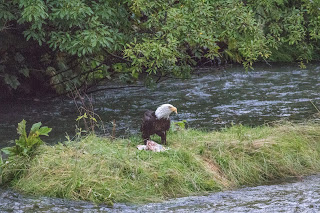 |
| US Highway 2 in Montana |
 |
| Harvesting peas |
 |
| Wheat harvest in Montana |
 |
| OK, here's my version of art. |
And then, there are some real surprises. We spied a small lake with pelicans. Pelicans? Yup, We had no idea we could find pelicans this far north but that's the beauty of driving on Hwy 2 instead of the interstate.
We were heading eastbound and enjoying the scenery. Carolyn was checking the map and said, " you know, we will be close to the Theodore Roosevelt National Park". We had visited this park in 2015 and enjoyed it very much – we still had plenty of time to make it home before our mid August timeline so decided why not see this fun park again?
The area around the Theadore Roosevelt National Park is pretty remote but energy has changed some of the solitude. In fact, Watford City that is only 15 miles north of TR NP is considered by many to be the center of the oil boom that began in the early 2000's. But nearby, there are also a few electricity generating windmills. I hope both forms of energy are successful.
 |
| Theadore Roosevelt National Park - North Unit |
 |
| Concretions being exposed through erosion |
 |
| A "cannonball" that rolled to the area below. |
There are views of the Little Missouri River...
 |
| Civilian Conservation Corps shelter overlooking the Little Missouri River |
We were also fortunate to see a lot of wildlife.We arrived at the park around 6pm, a perfect time to see critters out for their evening stroll. Just a couple miles from the entrance, we saw several longhorn steers from the small herd that is maintained in the park. Then we spied this mule deer and two fawns in a wooded area. Another mile up the road, we saw a number of bison. We stopped to take photos as they moved. Soon, the herd was in front of us and blocking the entrance to our campground. We patiently watch until they cleared the road and allowed us to reach our camp site.
The bison were in rut (that's when the guys are looking for the ladies). There were low "growls" from the males and it was not hard to figure out the dominant bulls. We were getting situated in our camp site when the herd made their way to some trees a couple hundred yards from us. I grabbed my camera and headed toward them. I was about 75 yards from them and standing beside the restroom incase I needed a safe space when all hell broke loose between two of the big bulls. The video below is raw footage as I shot it. Holy Toledo, it was intense!!!
Click on this link
We were also fortunate to get a heads up from a Park Ranger that the Bighorn sheep were spotted near Long-X pull off. We quickly headed there and were rewarded with a rare glimpse of a dozen or so Bighorn sheep.



























































